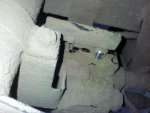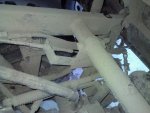They surely make gauges to check output of hydro systems. I had to buy gauge to check the output of my fork hydros on my tractor when I was replacing shims in the control passages of the pump controls/levers.........I put that gauge on the end of the hose to see how much pressure it was building after adding a shim or replacing them............
What was running or causing the fluid to get so hot. Border Collie refers to this above when she added a cooler to her lines and the hole in his tank is what I was referring to in my above comment.................What was causing this heat? Yes, of course work; but friction in the pump? Where was the friction..........??
Ok, so the guy kept running it without the cooling that the fluid was giving though inadequate. What part was running so hot to cause this and wouldn't that be where the damage is?????
What was running or causing the fluid to get so hot. Border Collie refers to this above when she added a cooler to her lines and the hole in his tank is what I was referring to in my above comment.................What was causing this heat? Yes, of course work; but friction in the pump? Where was the friction..........??
Ok, so the guy kept running it without the cooling that the fluid was giving though inadequate. What part was running so hot to cause this and wouldn't that be where the damage is?????






